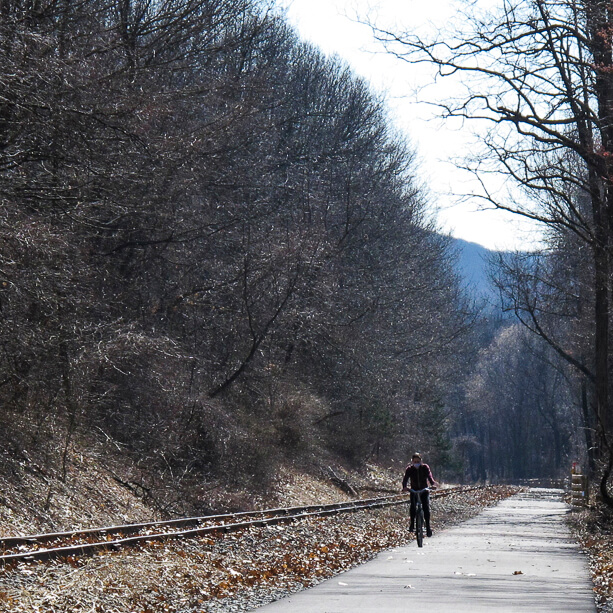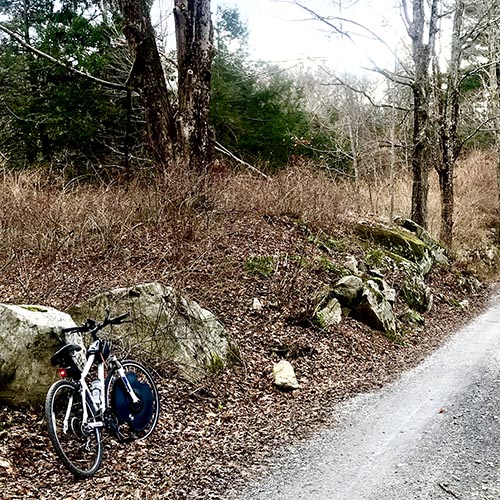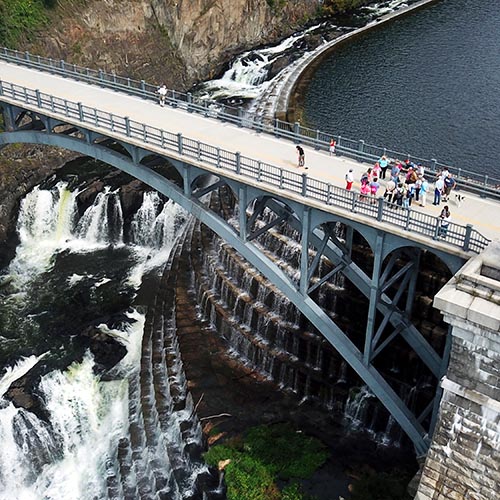FAQs
(Or, Questions I Pose to Myself)
Here I’ll answer questions that aren’t frequently asked but might be helpful when you’re planning your ride.
![]()
FAQs are rarely frequent, or even asked. But here I’ll answer some questions that might come up as you’re planning your ride.
Are any of these rides accessible by train?
Yes! I’ve created a couple of routes that are close to train stations. The stations are serviced by Metro-North trains and Amtrak, whose Lakeshore Limited and Maple Leaf routes allow carry-on bikes. Metro-North trains also allow you to bring your bike aboard, with the bike pass — at $5.00, it’s a bargain and never expires. I’ll be creating more of these rides in 2021. The rides are posted under the menu heading, “By Train”.)
What kind of bike works best on these rides?
Almost all of the routes here include some extent of dirt road, unpaved, rutted, or otherwise bumpy backroad. This is no place for a thin-tire road bike! A wider tire will be more comfortable, but a hybrid bike works fine.
Are there places on these routes to recharge my bike?
Most of these rides travel through backcountry, so you won’t find outlets out in the woods. I usually start and end in a town or county park, which often have power outlets, either attached to a gazebo or public restroom block. So, I recommend always starting with a battery full of juice, and bringing your charger along in a backpack, just in case.
Are you working for anybody?
Nope! This is an offshoot project of Allman Environmental Services Photography, my photography company. One of our driving forces is a love of the outdoors, and creating these routes is a pleasant diversion from photographing big infrastructure projects. But it’s still an integral part of what we do: draw people to beautiful places.
We are happy to put together custom routes for county tourism offices in New York, Connecticut, and New Jersey, with write-ups and photography. Feel free to reach out if you’re interested in working with us (email me: [email protected]). It’s a great way to draw bicycle tourism to your corner of the world, without the expense of building bike lanes and trails, or widening shoulders. Chances are you already have e-bike friendly byways to explore.
How do I get my electric bike to the start of a route?
Transporting your bike is an important consideration. It’s vital to prevent the nightmare scenario of a heavy electric bike bouncing off the back of your car and, God forbid, into oncoming traffic. Most trunk-mounted bike racks carry a limit of 35 pounds or so, and electric bikes most often exceed that weight limit. And it’s nearly impossible to horse a 50-pound bike to the heights of your roof rack.
I recommend the hitch-mounted racks for safety and security. Ask the guys at EBikesHQ.com:
“All of the best electric bike racks that I’ve found are hitch-mounted racks. There are a few reasons for this:
- Hitch mounted racks generally have higher weight capacities than other types of racks
- They offer more flexibility in loading/unloading your trunk, with many hitch mounted racks having a ‘tilt’ function to give access to your trunk while your ebikes are still mounted to the rack
- Hitch mounted platform racks, which support the wheel of the bike, offer the most flexibility for a variety of bike sizes and frames. With electric bikes the center of gravity isn’t always in the center so supporting the ebike by the wheels offers better stability and support.”
If your bike has quick-release wheels, sometimes it’s easy just to remove the front and/or back wheels and stow the bike inside your vehicle. Otherwise, an electric bike trailer is often the safest option here.
More e-bike routes you might like:

An Empire State Trail Loop Ride: The Maybrook Trailway Past Whaley Lake

The Fahnestock

The Sherman

